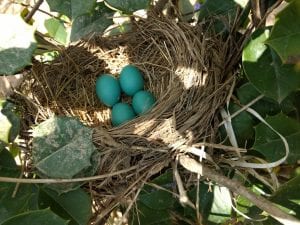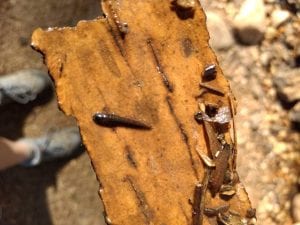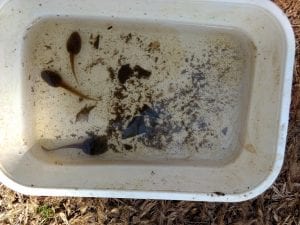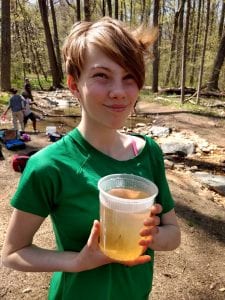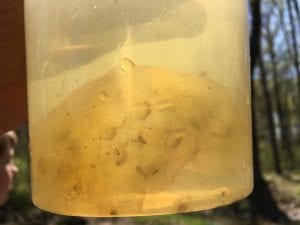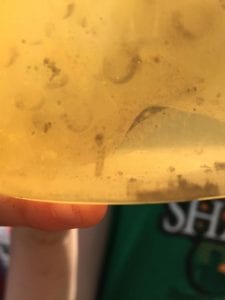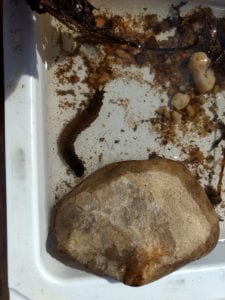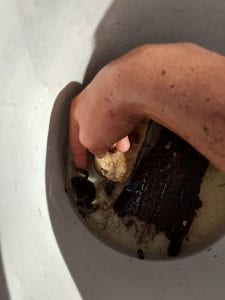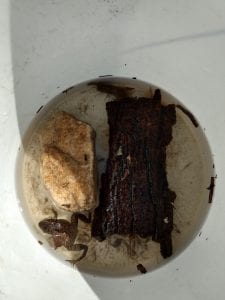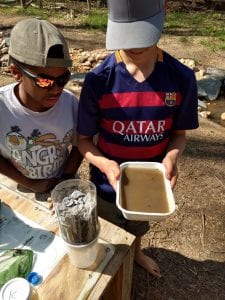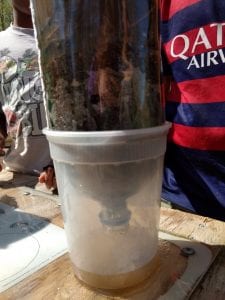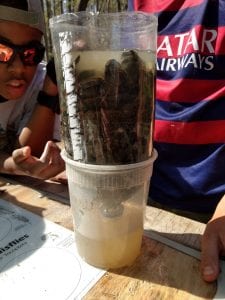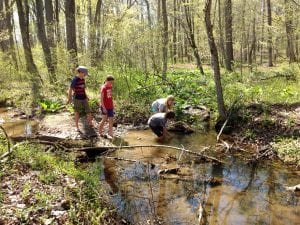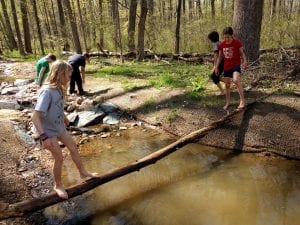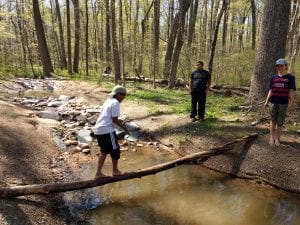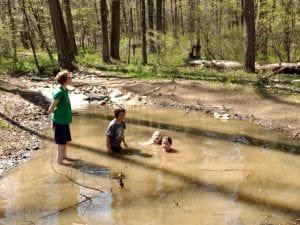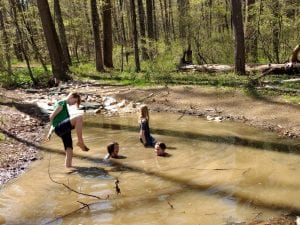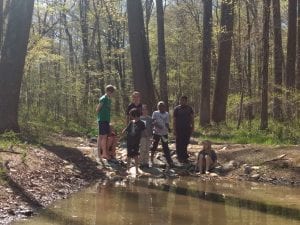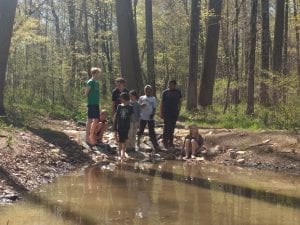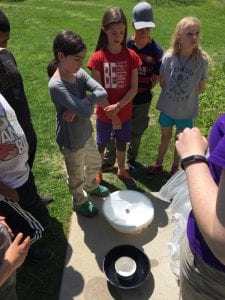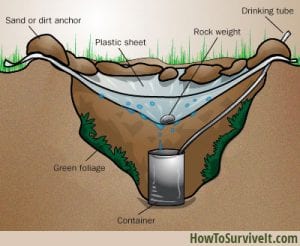5/1/2018
Today the weather was hot, the sun was blazing and there was barely a cloud in the sky. On such a hot day a lot of us were thinking about water. We reviewed what we learned last week by going over the three components of a wetland (water, hydric soil and hydrophilic plants) and then we moved onto some animals with amazing water adaptations. We had three examples, the first is a desert beetle that comes out only once or twice a year to the tops of the dunes to collect water in the form of dew on it’s back. The micro design of its exoskeleton allows the water to condense on its back, thus allowing the beetle to drink the water. Our second example is of bird beaks and their ability to collect condensation on the inside of their beaks and funnel that water to their throat to drink. People have started designing metal plates in the shape of bird beaks that will collect water condensation in dry areas for people struggling to find adequate water. And our last example is of a bird called a sand grouse that lives in one of the driest deserts on the planet. The male sand grouse has specially designed feathers on its underside that soak up water. He flies a great distance to small watering holes, sits in the water to let it absorb and then flies home to his young, trying to avoid being taken by a predator. Another example that Piper mentioned was the horned lizard that has specially designed scales that help it collect water and transport that water down to its mouth, she also drew it in her journal!
You can explore the three examples of animals and water adaptations that we talked about in class in the links below:
https://asknature.org/strategy/water-vapor-harvesting/#.Wuhstech270
https://www.asce.org/magazine/20140930-bird-beaks-inspire-fog-catcher/
https://www.birdnote.org/show/sandgrouse-desert-water-carriers
Before heading out to the creek and ponds to look for animals that call the aquatic world home, we created a solar still to demonstrate a way that people can collect water similar to how some of the animals collect water using condensation. A solar still (a solar still design is pictured in the gallery below) is used to either evaporate and condense water for collection from vegetation or it can be used to purify dirty or salty water. In today’s example we were attempting to purify saltwater to make it drinkable. We set up a solar still before class to get the process going (since it does take a long time to get results) and then we built one with the class to go through the process. For our solar still we had a large bowl filled with a few inches of saltwater (we warmed it a bit to speed things along). Inside the large bowl is a smaller, heavy bowl. We then covered the large bowl in thick, opaque plastic, taped the edges and left a bit of slack. We then placed a rock in the center of the plastic. As we created our solar still we discussed the water cycle, evaporation powered by the sun, condensation and precipitation. The water would evaporate, condense on the plastic (form water drops) and then drip along the plastic and precipitate into the bowl. Below, Eva is tasting the saltwater from the larger bowl (not in the picture) and then tasting the fresh water in the small bowl she is holding. The solar still worked and completely removed the salt from the water (we checked it at the end of our day). Meanwhile, as our solar still worked its magic we hiked down to the the forest ponds and stream.
On our way to discover aquatic animals we found a jack in the pulpit along the trail. Jack in the pulpit looks like a pitcher plant and has three large green leaves. It isn’t a true pitcher plant, the pitcher part of the plant is merely a way to protect the flower inside. Walking along the trail we spotted a nest and peaked inside. See the gallery below to view the beautiful robin eggs we found! Mom wasn’t too far away, we saw her in the tree nearby. We also found wild violets along the trail and in the meadow and tried them. Everyone agreed they tasted pretty much like grass but they would be a pretty addition to a salad! We also tried the buds of the native red bud tree. Another experiment we were going to do today was create and test a homemade water filter. Using a 2 liter bottle with the bottom cut off you fill it with various layers to create a rustic water filter that can actually work in a survival situation (you can substitute the bottle for anything that forms a funnel like shape). We stuffed the bottom with grass to prevent anything from falling out of the small top. Then, we found small pebbles and built up a one inch layer. Next, we stopped by the barn and made a one and a half or so inch layer of crushed up charcoal. Next we put more small pebbles on top of the charcoal followed by larger rocks. Ideally your filter should have a layer or two of silt in it to help filter out the smallest clay particles from your water but since silt is hard to come by here we skipped it. There is likely some at the creek but we wanted to finish our filter before then. Once we got to the creek we set our filter aside to test it shortly. First, we wanted to explore!
Treading carefully, we searched the stream and ponds for tadpoles and frogs. We found some huge green frog tadpoles (see below) and Lev caught a gigantic crayfish. We did find a large number of frogs but they were all too fast to catch. Piper did eventually catch one and we put it in a bucket with some natural materials to view it before letting it go. Another amazing find was a huge mass of salamander eggs and babies. Piper found what looked like jelly in the stream, gently scooped it up and once we got to take a closer look at it not only did we identify it as a salamander egg mass we saw tiny salamander babies in it! They had just hatched and most were still in the egg mass. You could see their long slender bodies and two tiny gills on their heads. Baby salamanders are called nymphs because they go through metamorphosis like frogs but don’t enter a pupa stage. For insects like a butterfly, a caterpillar is called a larva because it goes through a pupa stage. A grasshopper on the other hand does not go through a pupa stage and the baby looks a lot like the adult so it is referred to a nymph. Other cool animal finds included a crane fly larva, a water beetle and water beetle larva and an alderfly. Check our our gallery below to see some of these animals!
Next it was time to test the filter. We gathered some of the yuckiest, muddiest water in the pond and poured it into our filter. We watched it pass through the layers with the finer silt and clay getting trapped on the rocks and pebbles. The water that came out on the first pass through was cleaner but still dirty. You definitely have to run it multiple times to get a good result. We passed the water through the filter 6-7 times and by the last time it definitely looked a lot clearer. If we had had that silt layer somewhere in our filter it most likely would have been even cleaner! Don’t worry, we didn’t actually drink this water!
Before heading back to Irvine, with the thermometer reading almost 90 degrees, some of us decided to take some dunks in the water. We also practiced our balance on a log. It was fun getting wet and dirty in the pond! We remained careful not to walk to quickly through the water, remembering these are homes to a lot of animals. Pictures in order: robin nest with eggs, alderfly, green frog tadpoles, Piper with the salamander babies, cranefly larva, Elias with the crayfish, green frog adult, testing out the water filter. Solar still graphic is at the end.




